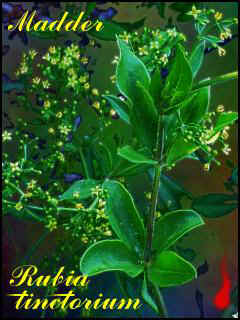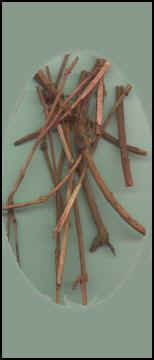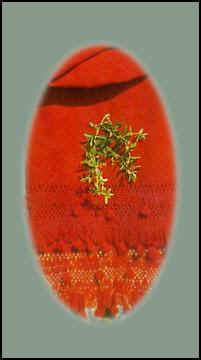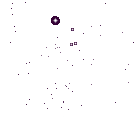~~* Black Sheep Newsletter............Issue 108............Summer 2001 *~~
 †
†
THE HOMESTEAD: A dyers garden
Summer thrust herself upon us in southern Oregon way before her time. From mid-May to the end of the usually cool month, it ended up being horrifically hot. Temperature records were set in cities like Roseburg and Medford, and here on this goat ranch I battled with the frustration of trying to ready garden beds without the usual spring rains that do their beneficent work - "watering" for me while I slept.![]()
Of course I write this with the hope that more rain is on its way – maybe in the form of unexpected "summer" rains. I'm hoping the prognosticators will be wrong this time around (they're telling us to be prepared for one of the driest summers on record.) I'll cast my lot with the old timers who always quip, "If you don't like the weather in Oregon, wait 20 minutes - it's bound to change…"![]()
Still, I can't complain. The goats have lush pasture grasses and tremendous forage this year in spite of the dry winter and spring that we have seen. The miracle of new birth abounds not only in the plant life, but also in the goat pens. I have said it more than once when I've written for this periodical – but again I reiterate: "color, color everywhere!"![]()

Madder
I love to watch the goat kids while all of us take our daily stroll up the mountain. Those kids always "hang out" together, inseparable most of the time – and lagging far behind the adults in the group. I'm behind them (having to constantly monitor their tendency to "drift far away" and then begin squalling for their mothers which alerts every predator in the vicinity!)![]()
All I see are glimmering and colorful fleeces. A jet black doeling runs alongside her twin, another doeling the color of a walnut. Right behind is a zealous kid buck, almond in color (whose testosterone levels seem preposterously high for a three-month old!). My eyes then turn toward another little buckling whose fleece is as red as cayenne pepper. Off to the side is another doeling who was born black, but is now silver. All this color makes me think of spinning mohair, and spinning mohair always makes me think of weaving mohair. It's a vicious circle and I'm caught in its vortex.![]()
August Blackberries and the Dye Vat
I'll try to tie the two together – those wonderful blackberries that I pick every year with a vengeance, and the dye vat.
When the blackberries begin to ripen in these southern Cascade mountain ranges, in their midst is where you'll find me. The gentle sounds of the big river are soothing while it meanders past, and I often lose all track of time or the tendency to be rushed about life when I'm out there amongst those brambles![]()
And while I'm there, dear reader, I take careful note of that blackberry bush's colors, for its brilliance and subtlety always catches me off guard. There are berries painted dusty pink and there are others even more muted, nearly white. There are the ones the color of raspberries, glowing red. The fully ripe berries, of course, are painted deep purple, like a Concord grape. Golds and bronzes are always intricately woven into the palette, and the backdrop of green only enhances the spectrum. Each year I find myself making a promise: "this is the year I weave a garment EXACTLY these colors…"![]()

Dried roots of madder

Brilliant Reds of Madder
Nature has a way of blending color expertly, and she rarely makes a mistake. A weaver can learn a lot about color by watching how deftly nature strokes her brush in order to attract pollinators with her beauty.![]()
I am a fiber artist, after all. Just as a photographer cannot view a flower without seeing it framed by the camera lens, so I find it to be. Forever examining the "color chart" that nature chooses, I love attempting to duplicate it on my own "canvas" – the weaving on the loom.![]()
Mohair – a Dyer's Dream Fiber/Natural Dyestuffs and Their Mordants
Mohair takes to dye like ducks take to water. That is known fact. Of course I do not dye any of the fleeces from our naturally colored flock, but many of the white mohair fleeces on this farm find their way into woven goods after they have seen the dyepot. I have utilized chemical dyes many times and had incredibly lovely results. If given a "choice", however, I lean toward dying my yarns naturally.![]()
One of the prettiest mohair throws I have ever woven was a purely black one (from a purely black angora kid goat.) Incorporated into the black blanket was a "plaid"design made of yarns which I had dyed a dusty rose color with "cochineal" (a hard-bodied insect that hails from the southwest United States and Mexico.)![]()
As with most natural dyes, you can obtain a full spectrum of color from one dye – depending on which mordant you utilize. (Reader: A mordant is a substance that treats the wools before the dyestuff is added, causing greater uptake of dye into the fibers, color fastness (sunlight and washing) and increase the range of colors dramatically. For instance, with cochineal:
Alum mordant - clear rosy reds and pinks
Chrome mordant – purplish reds and pinks
Tin mordant – full scarlet
Iron mordant – greyish violet
Over the years I have experimented with many natural dyestuffs and mordants. Warning: One must be very careful when handling tin or chrome, for they are inherently poisonous when care is not taken. To be honest with my readers I must admit that I have not yet worked with these two mordants (tin or chrome) for I've been a bit intimidated by the thought that I might be, in the long run, harming my body. However, in time, I hope to utilize even these which have been used by dyers of fiber for centuries, for there are some colors that I will never obtain using my usual alum or vinegar mordants. – especially a soldier red from madder.![]()
Then There is Indigo
Dying with indigo involves just a bit of knowledge of "chemistry", but it is not a difficult process. I don't think that I've had more fun with dying yarn than I did those days I brought my skeins of handspun mohair out into the sunshine along with my "blue pot"** mordant and the crystalline indigo. The blue obtained from this dyestuff was unique – the color more like denim blue, muted and subtle, and certainly not as stark as chemically dyed blues in my opinion.![]()
So this past spring when one day, unexpectedly, a little package of seeds labeled "indigo plants" arrived in the mail, Stan and I thrilled. At first I wondered if we could actually hope to dye from just a few indigo plants (I thought I would need an acre or so of indigo to really do much good.) So, I decided to do some research. My favorite dye book, "A WEAVER'S GARDEN" (Rita Buchanan) says this:![]()
Individual batches vary considerably, but the pigment extracted from a pound of fresh woad leaves should dye from two to four ounces of fibers; a pound of Indigofera or ‘dyer's knotweed leaves' will give enough pigment to dye four to eight ounces of fibers…![]()
Gardening in Virginia, I found that the leaves from two dozen plants of I.suffruiticosa were enough to dye two pounds of wool a rich navy blue color.![]()
madderred.jpg (10016 bytes)
My own present "weaver's garden" grows with an abundance of madder, whose gnarly roots are used for the dye. In this garden are also all my "moth repellant" plants - the wormwood, the mugwart and the rosemary that is nearly 4 feet high and 4 feet in width, its long spikes of blue flowers the color of a summer sky. A long bed that skirts the top of the garden houses the lavenders, which when blooming simultaneously, cloak summer with their perfume. I love lavender for a number of reasons, but mostly because it does such a good job repelling the moths. Full bouquets of lavender spikes adorn the house after I've gathered them in July, after I've done my annual "moth egg" search in every fiber basket and blanket chest I own.![]()
An empty garden bed next to the madder will welcome the indigo plants. Someday in the not so distant future, with cutting tool in hand, I hope to harvest a crop of indigo leaves and follow all the instructions to the letter, dying those skeins of mohair indigo blue, naturally!![]()
**A blue pot was always kept in the dyer's homes, a well aged cask of urine to be used as a mordant, especially for the indigo.![]()
Alexandra Scribe
Homestead Home
TOP






